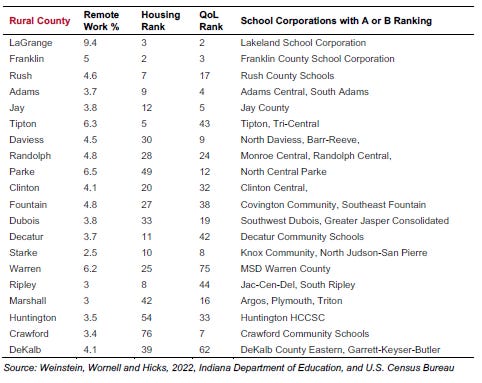This is a chapter excerpt of the State of the Rural Indiana study recently released by the Ball State Center for Business and Economic Research. It was done collaboratively with the Indiana Communities Institute and the Center for Local and State Policy at the university.
The Coronavirus pandemic will lead to many long-term economic changes, particularly in aspects of the labor market that affect rural places. The most obvious change is the sudden growth of remote work. This development, which was accelerated by the pandemic may sever the link between work and domicile for a substantial share of American families. This will lead to significant geographic reallocation of households that may benefit some rural places.
The rapid urban population growth during the 21st century is influenced by both the amenity rich environment around large urban places as well as the opportunity for more productive employment. Similarly, skilled workers in urban places don’t only earn more than those in rural places, they also produce more. Thus, metropolitan places grow more rapidly than non-metropolitan places. The advent of a large, sudden growth in work at home opportunities may result in considerable changes in household location decisions.
A number of studies attempt to quantify the potential range of affected workers. Among them is a McKinsey study that reports between 20 and 25 percent of jobs could be performed remotely for three to five days a week. Another study reports that as much as 56 percent of American workers can work at least part-time from home.
A technical analysis of the persistence and nature of work-at-home concludes that a considerable share of work will be permanently conducted from home or remote offices (Bick, Blandin and Mertens, 2001). These studies all suggest that many families, perhaps one in four, will experience some reduced need to live within an easy commute of work. For some, this will mean a complete severing of the geography of work from home. For most remote workers there will be some remaining connection between work and home, since they will need to commute once or more day each week to their place of work. In the outset of this study, we noted the compactness of Indiana’s geography. Nearly all Hoosiers live within an easy commute to an urban location. However, there is still a great deal of rural land across Indiana, and for households with a preference for small town or rural living, the post-COVID workplace opens up significant options.
A full accounting of the post-COVID geography of work is outside the scope of this study, but we have significant information about the likely places households will seek out in rural Indiana. Using this information, we estimate the rural places in Indiana that are likely to grow in the coming years. First, a note about our methodology. As described in our Quality-of-Life chapter, we can measure of the amenity-based value families implicitly place in each county’s housing stock. We combine this with the share of home-based workers prior to the pandemic under the assumption that there is some combination of private and public infrastructure (e.g., airport access, broadband, or locally available meeting or teleconferencing services) that supports remote work.
Finally, we include only those counties with at least one school corporation scoring an “A” or “B” in the most recent school ranking because of the strong correlation between school quality and location decisions. Importantly, this includes about two-thirds of schools in Indiana, so we are not excluding a large number of counties. (Note, that if we group school corporations by grade, only the A graded group saw enrollment growth in the most recent year). The top 20 rural counties we expect are likely to grow in a post-COVID environment are reported in Table 1.
Table 1, Top 20 Rural Counties Projected for Post-COVID Growth
It is important to note that this listing is not exclusive, and it is not a formal forecast. The goal here is simply to highlight the counties that already display the characteristics we believe will be connected to the post-COVID changes to residency. There are also many urban places that are likely to perform well in this measure. Communities like Shelbyville, Daleville, Greenfield, and Yorktown lie within urban counties but have high quality schools and growing communities that would appeal to newly footloose families.
It is likely that the adjustment process to the COVID-19 pandemic will continue for a generation. The housing adjustment to the Baby Boom shock continued well past the birth of the youngest of that generation, and households will continue to adjust their occupational and career choices to take advantage of workplace changes from the pandemic. Thus, communities who wish to take advantage of a more modest link between residence and workplace can still benefit from making appropriate adjustments.



